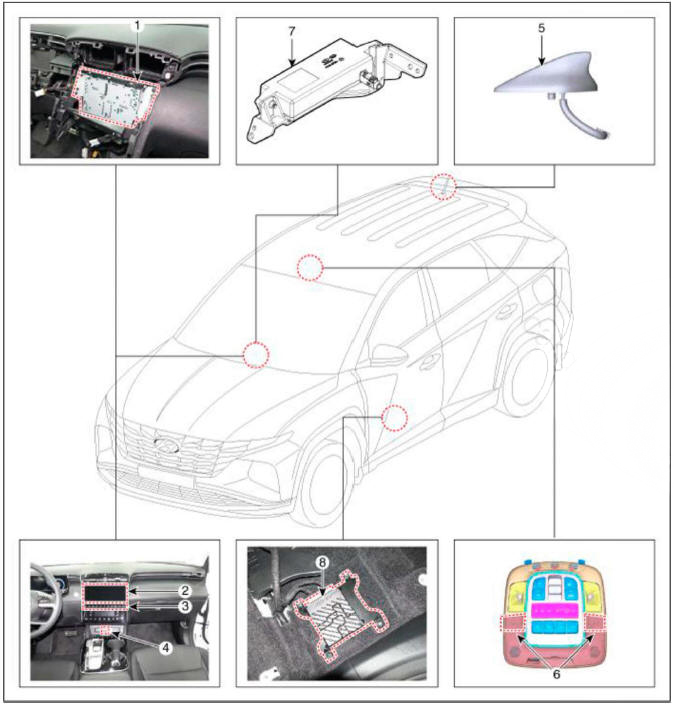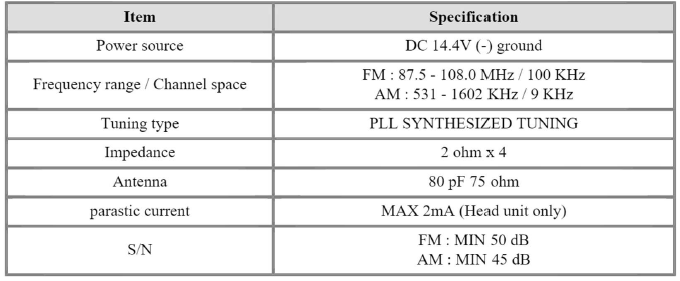Hyundai Tucson: AVN System
Description
AVN system
The AVN system has improved information search and easiness of manipulation for the driver by simplifying the system operation experience and unifying the display of the user information such as multimedia and car information.
- The system is basically composed of a keyboard for the operation of combined function, LCD monitor, a head unit with Bluetooth handsfree calling, voice recognition and navigation, music amplifier and the media unit that connects with other outside devices.
- Simplification of user interface : the multimedia and car information are displayed on the monitor.
- Networked electronic parts : Efficient information transmission through CAN communications.
- Up-to-date technologies integrated :
- Voice recognition : This function recognizes the user's voice commands to manipulate the system. The user can issue voice commands to operate AV system, Bluetooth phone and navigation and connect to Cubis call center.
- Bluetooth hands-free calling : This is compliant with the international
wireless communication
standards and uses bluetooth technology adopted in most currently launched
mobile phones.
Once connected, it is automatically linked to the driver's cell phone whenever the driver gets in the car.
- USB connectivity : External music devices like USB memory stick, are connected and played through the car speakers.
System Block Diagram
Limitations Of The Navigation system
GPS Signal Reception State
As the GPS satellite frequency is received/transmitted in straight lines, reception may not work if hiding devices are placed on or near the GPS antenna or when traveling through the following locations.
- Tunnels
- Basement parking structures
- Underneath an overpass
- Roads within forested areas
- Areas near high rise buildings
- Roads within canyons
Vehicle Position Display
- If multipass errors occur due to reflections from buildings or related causes, the current position mark on the navigation may differ from the actual position of the vehicle.
- The position of the vehicle on the navigation may be different from the actual position if the vehicle is under the occur, driving for a short period of time will vehicle through map matching or GPS information (several minutes may be necessary in certain cases).
- When driving on a Y-shaped road with a narrow angle, the current position may be displayed in the opposite direction.
- If the vehicle is loaded onto a car transport vehicle, the current position mark may be stalled on the last position prior to loading.
- When driving on a spiral-shaped road.
- When driving in mountain regions with sharp turns or sudden brakes.
- When entering a road after having been in an underground parking structure, building parking structure, or Unliable with many rotations.
- When the tires have recently been replaced (Especially upon use of spare or studless tires)
- If the batteiy terminal is removed.
- When driving in city streets, the current position may be displayed on the opposite side or on an off-road position.
- When changing the zoom level from the maximum zoom in level to a different zoom level, the current position mark may be displayed on a different road.
- When driving in heavy traffic with frequent go - stops in traffic or intersections.
- When driving under slippery conditions, such as heavy sand, snow, etc.
- When driving with the tire chain in place.
- When using a tire with an incorrect size specification.
- When the tire pressure for the 4 tires are different.
- When the replacement tire is a worn or used tire (Especially studless tires having passed a 2nd seasons, etc.)
- When driving near high-rise buildings
- If a roof carrier has been installed
- When driving under high speeds or having calculated a long-distance route.
Route Guidance
Suitable route guidance may not occur caused by search conditions or the driving position.
- Guidance to go straight may be given while driving on a straight road.
- Guidance may not be given even when having turned at an intersection.
- There are certain intersections in which guidance may not occur.
- A route guidance signaling entrance into a no enter zone may occur (No enter zone, road under construction, etc.)
- Guidance may be given to a position removed from the acUial destination if roads to reach the actual destination do not exist or are too narrow.
- Faulty voice guidance may be given if the vehicle breaks from the designated route (ex : if a turn is made at an intersection while the navigation provided guidance to go straight).
- Map Data may be missing or incorrect causing route guidance to not be given.
Route Re-calculation
The following phenomena may occur after conducting route recalculation.
- When turning at an intersection, the navigation system gives wrong information on the current position.
- Route recalculation may take a longer period of time when driving under high speeds.
- A route guidance signaling for a U-Turn in a No U-Turn location may occur.
- A route guidance signaling entrance into a no enter zone may occur (No enter zone, road under construction, etc).
- Guidance may be given to a position removed from the actual destination do not exist or are too narrow.
- Faulty voice guidance may be given if the vehicle breaks from the designated route (ex : if a turn is made at an intersection while the navigation provided guidance to go straight)
Components Location

- AVN (A/V & Navigation head unit)
- Front monitor
- AVN switch
- USB jack
- Roof antenna
- Mic
- Crash pad antenna
- External amplifier
Specifications

READ NEXT:
 Emergency Call System
Emergency Call System
Description
Emergency Call (eCall)
When an accident occurs or the user's request is detected, it notifies the
call center of the vehicle status using the wireless
network so that the center can provide necessary emergency service.
Em
 Configuration of eCall Controller
Configuration of eCall Controller
Input button & Indicator
SOS button : Press the button to place a call to the call center.
LED indicator lamp : The red and green LEDs turn on for 3 seconds after the ACC
is on and stay turned off in standby until
the key is turned off
 Inspection with Diagnostic Tools
Inspection with Diagnostic Tools
In the eCall system, failure can be quickly diagnosed by using the vehicle
diagnostic system.
The diagnostic system provides the following information.
1) Self diagnosis : Checking failure and code number (DTC)
2) Current data : Checking the s
SEE MORE:
 Fuel requirements
Fuel requirements
Gasoline engine
Unleaded
Your new vehicle is designed to use only unleaded fuel having an octane
number
((R+M)/2) of 91 (Research Octane Number 95) or higher. (Do not use methanol
blended
fuels)
Your new vehicle is designed to obtain maximum
 Steering wheel - Disassembly
Steering wheel - Disassembly
Disassembly
Loosen the paddle shift switch mounting screw (A).
Remove the paddle shift switch (A) after disconnecting the connector.
Remove the lower cover (A) after loosening the screw.
Disconnect the wiring
Information
- Home
- Hyundai Tucson - Fourth generation (NX4) - (2020-2023) - Owner's Manual
- Hyundai Tucson - Fourth generation (NX4) - (2020-2023) - Workshop Manual